| THEME#2 >>> (IM)MOBILITY / BORDERS, LABOR, MIGRATION | Next Theme / Themes Home |
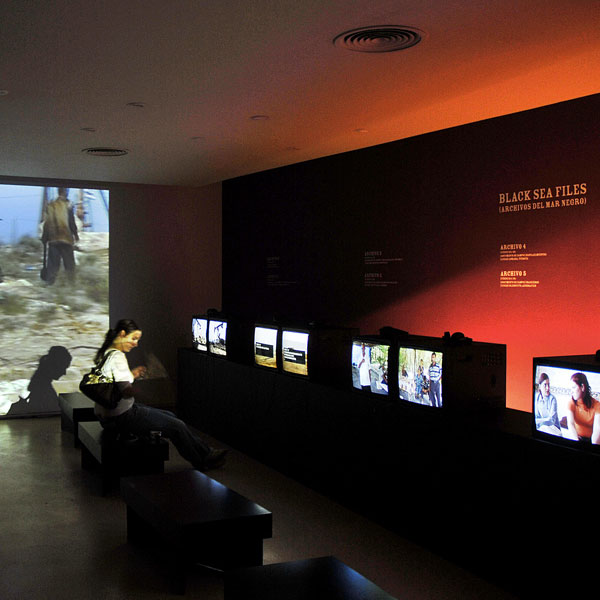
The Black Sea Files / Ursula Biemann
Black Sea Files is a territorial research on the Caspian oil geography: the world's oldest oil extraction zone. A giant new subterranean pipeline traversing the Caucasus will soon pump Caspian Crude to the West. The line connecting the resource fringe with the terminal of the global high-tech oil circulation system, runs through the video like a central thread. However, the trajectory followed by the narrative is by no means a linear one. Circumventing the main players in the region, the video sheds light on a multitude of secondary sceneries. Oil workers, farmers, refugees and prostitutes who live along the pipeline come into profile and contribute to a wider human geography that displaces the singular and powerful signifying practices of oil corporations and oil politicians. Drawing on investigatory fieldwork as practiced by anthropologists, journalists and secret intelligence agents, the Black Sea Files comment on artistic methods in the field and the ways in which information and visual intelligence is detected, circulated or withheld.
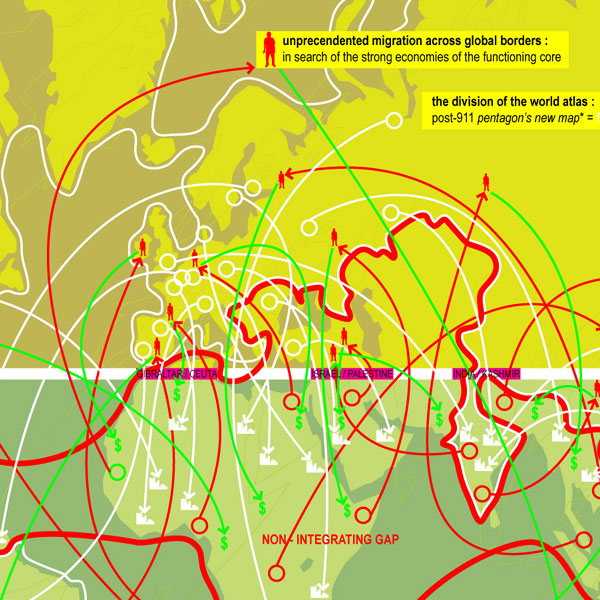
Levittown Retrofitted: An Urbanism Beyond the Property Line / Estudio Teddy Cruz and Casa Familiar
In the context of a post 9-11 political equator that divides the world and the city between enclaves of mega wealth and sectors of poverty, urbanities of labor and surveillance, the formal and informal, our institutions of architectural representation and display have lost their socio-political relevance and advocacy.
New experimental practices of intervention in the collective territory will emerge only from zones of conflict. The radicalization of "the local" in order to generate new readings of "the global" is transforming the neighborhood – not the city – into the urban laboratory of the 21st century. The micro heterotopias emerging within small communities across the world, provoked by social emergency, are producing non-conforming spatial and economic contingencies that will incrementally pixilate the large with the small, homogeneity with difference. These economic and political informalities generate a different idea of density and land use, a counter form of urban and economic development that thrives on social organization, collaboration and exchange.
Estudio Teddy Cruz
Teddy Cruz with Andrea Dietz, Adriana Cuellar, Jota Samper, Escobar, Mariana Leguia, Jesus Limon, Gregorio Ortiz, Alan RosenblumCasa Familiar
Andrea Skorepa with Luz Camacho David Flores
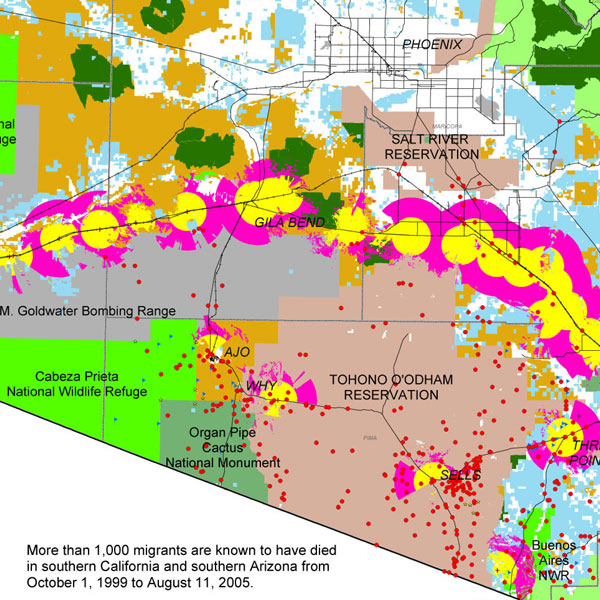
Water Station Maps and Warning Posters / Humane Borders and No More Deaths
Since our start five years ago, we have collected data and assembled maps of the Arizona border with Mexico to track favored migrant paths, as well as the locations where migrants die. This helps us make strategic decisions about where to collaborate with land owners and managers about water station placement, and also allows us to show, in a graphic way, how the water stations help mitigate the loss of life.
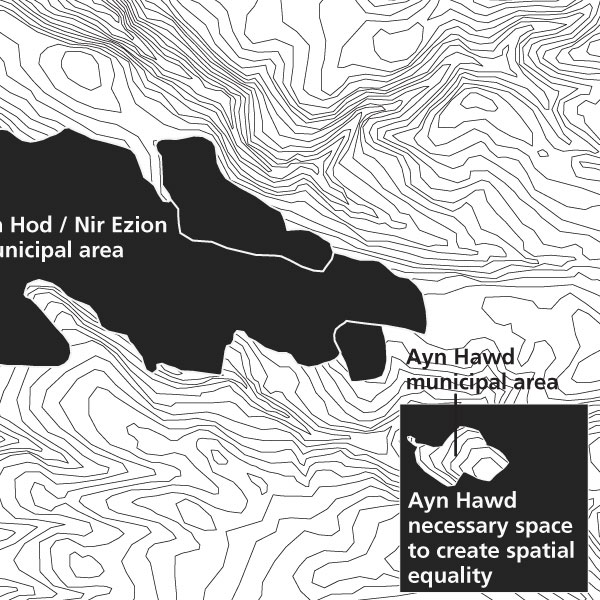
Spatial Justice for Ayn Hawd / Sabine Horlitz and Oliver Clemens
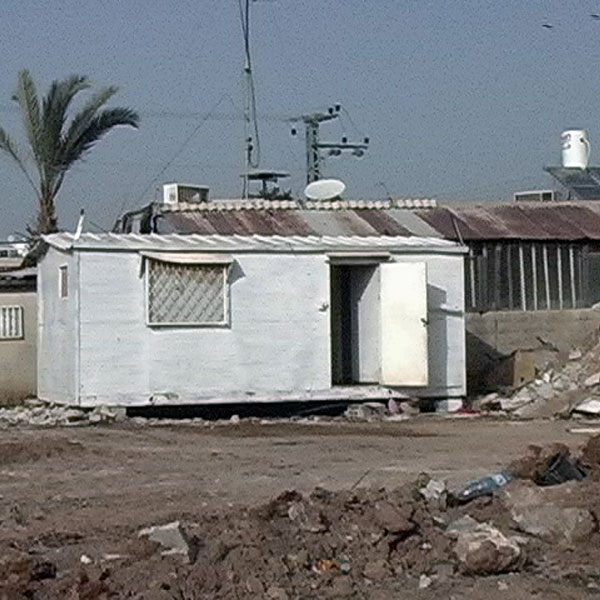
Searching for Our Destination / Ayreen Anastas and Rene Gabri
For a period of approximately 20 days, the length of our sojourn in Ramallah, we engaged with a variety of individuals: shepherds, thinkers, revolutionaries, street vendors, bus drivers, liars, shopkeepers, widows, peasants, prisoners, farmers, strikers, activists and artists. Our goal was to increase our knowledge of the Palestinian situation in a more immediate way; we did so through learning about the everyday experience of the people we encountered and about how Israeli measures, particularly in the West Bank, but also in Israel, suffocate the Palestinians, hinder them and attempt to destroy their lives.
Our initial proposal was to use our own research, as well as suggestions from friends and colleagues, in order to outline various itineraries through the West Bank and parts of Israel. The result was a series of trips which we documented through a variety of means. The documentation of each trip and of related discussions retains its own integrity and autonomy, and reveals specific nuances as well as challenges to any "settlement" project. This project resists containment, since the documents we present are only a reference to the journeys we undertook and the exchanges we participated in. Seen together, however, these documents pose a highly specific set of questions and concerns that come directly from the individuals whom we sought out, or who sought us out.
Ayreen and Rene's work was made possible by Liminal Spaces, a project which brought together artists, activists, and thinkers from Palestine, Israel, and Europe to consider the ongoing injustices and crimes which result from the occupation and the potential role art can play within such a context.
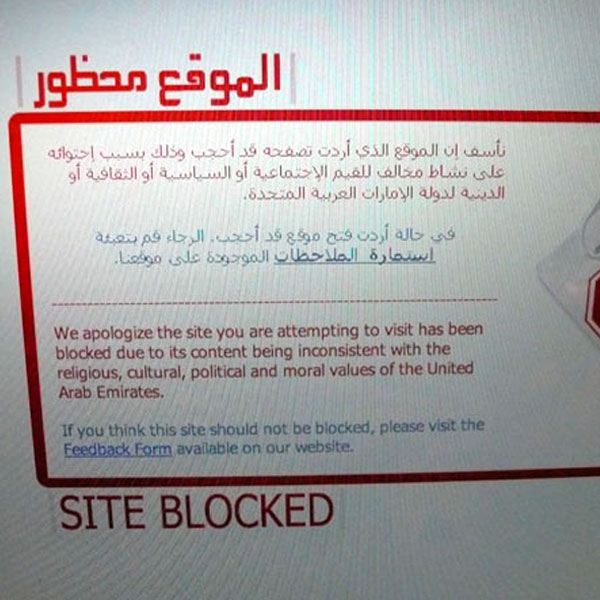
Host Not Found: A Traveling Monument to the Suppression of Search / Markus Miessen and Patricia Reed
The collaborative project grew out of the image of a blocked web site taken from Dubai, UAE. The image fore-grounded a larger investigation into the organization and spatialization of internet governance which in turn led to the development of a traveling monument proposal for the International Telecommunication Union (ITU). The ITU initiates summits and conferences around the world to address emerging communications technologies and their employment. Notably, ITU has partnered with the UN in 2003 and 2005, in organizing the World Summit on the Information Society (WSIS) in Geneva and Tunis.
As a mobile entity, we propose the installation of the Monument of Suppression of Search, to travel alongside the conferences organized by ITU. The title of the work borrows from terminology used by some national firewalls, who mask their filtering practices by serving up web pages reading "Host not Found" or "Connection Timeout." Likewise, the monument references the history of "moral monitoring" by referring to Anthony Comstock's (of the Comstock Act) founding of the New York Society for the Suppression of Vice (NYSSV), in 1873. The architecture itself appropriates Google Inc.'s real-time key-word stock-ticker and situates two diagonal LED displays directly into the ground. On one display, forbidden key words, SMS texts, chat words from around the world would quickly traverse downwards, in real-time as people surf the net – operating as a repository of suppressed search queries. The other would display features strings of Free Proxy IP addresses (updated in real-time) moving slowly in the opposite direction – acting as a billboard for the promotion of anonymous web surfing, thereby subverting firewalls and web censorship techniques.
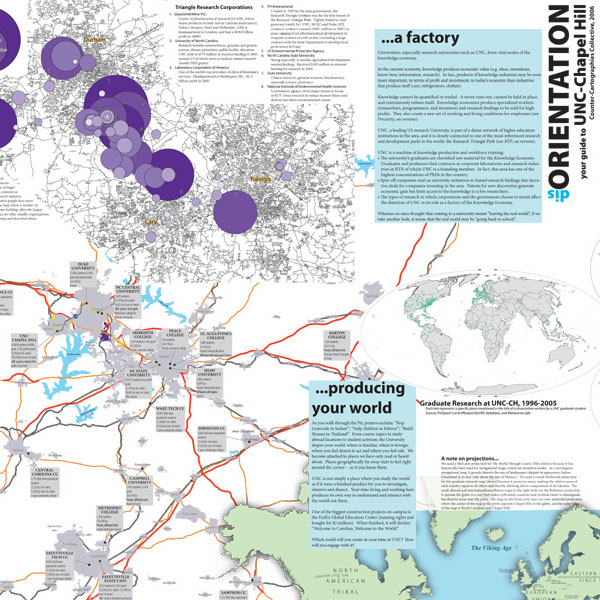
disOrientation Guide / 3Cs - Counter-Cartographies Collective
Over the spring and summer of 2006, 3Cs worked in collaboration with other campus and community groups to produce the first disOrientation map to UNC. Designed for incoming first-year undergraduate and graduate students, as well as new faculty, the map details UNC's local and global ties, decentering the notion of the university as "ivory tower" and positing overlapping and conflicting notions of UNC as "... a functioning body," "... a factory," "... producing your world". The map also contains gobs of useful information about courses offered at UNC, interesting community groups, even coffee shops!
| THEME#2 >>> (IM)MOBILITY / BORDERS, LABOR, MIGRATION | Next Theme / Home |